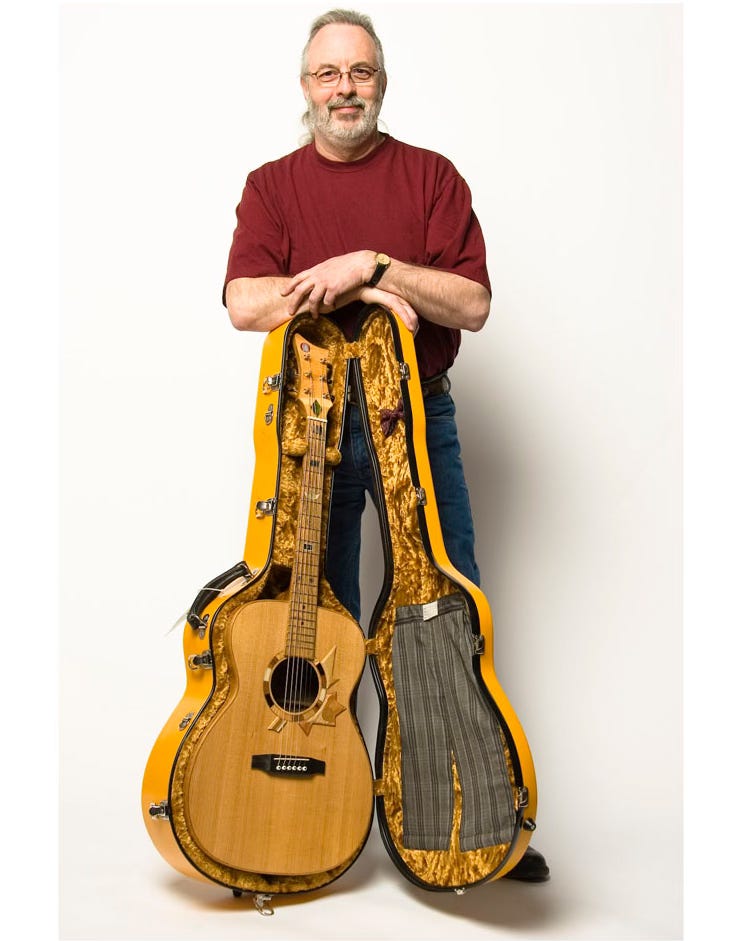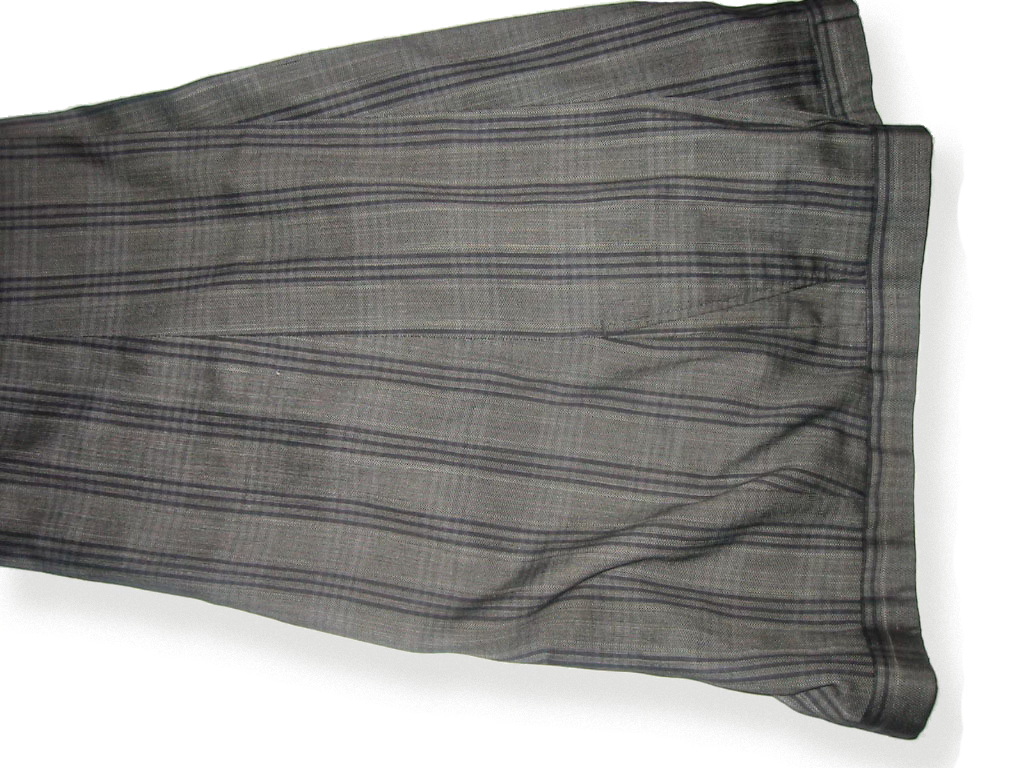This is the detail promised in the previous post about the contribution of material from René Highway, which has been sewn into a space created by the removal of some of Don Cherry’s pants that occupied much of the interior of the lid of the case.
Read straight through to the two short bonus stories at the very end!
Although I hadn’t been much of a hockey fan since my rabid childhood days as a supporter of the Chicago Blackhawks (mostly on account of how cool Tony Esposito looked in net and how much I enjoyed saying the name Stan Mikita) – I’d kind of given up on the game as a result of the rising popularity of the Bobby Clarke-era “Broad Street Bullies” style of hockey that coincided with the end of my house-league playing days – it was hard to overlook Cherry as a cultural phenomenon. He combined seasoned-vet insights, a hard-to-ignore blowhard speaking style and a highly entertaining peacock/harlequin appearance in his commentary segments with Ron MacLean; his “Rock’em Sock’em” hockey-fight compilation videos were advertised relentlessly on weekend TV and; in 2004, he inexplicably captured something like 4th spot in an audience-voted pick of “The Greatest Canadian” on a terrible, terrible CBC Television show of the same name (universal health care architect Tommy Douglas was voted #1). So it seemed like a good idea at the time to get something of Cherry’s to go into the guitar case (though I had a connection to Douglas’ son-in-law, actor Donald Sutherland, so why I didn’t go after that I can’t rightly say!). There were lots of sombre and serious historic elements in the guitar itself so this – the first addition to the case – would be an opportunity for a little levity and colour. Not that the case interior wasn’t already a bit colourful – it was lined with taxi-yellow fun-fur! In fact, when we bumped into Toronto Maple Leafs coach Pat Quinn at an airport baggage carousel in the fall of 2006 and was showing him the various hockey bits in the guitar, I told him what I wanted to do with the case and he said: “Are you kidding? When Don sees that yellow fun-fur he’s going to want to have a suit made of it!”
So in October of 2006, I reached out via “Hockey Night In Canada” and was put in touch with Don’s daughter, Cindy Cherry, who represented him in many matters. There was an initial phone call but mostly we just emailed and she was lovely. My request was pretty simple: some bit of fabric from one of those outrageous suit jackets would instantly bring Cherry to mind and provide a welcome pop of colour. At least, I thought it was a simple request. After her initial openness to the idea, things were going a little slower than I would have liked – especially since I needed to coordinate with Calton in Calgary to have the material installed. After a little prod on January 7, 2007, Cindy wrote back: “The thought of cutting up one of dad’s jackets I think may have been too much for him to bear” and offered instead a pair of pants he’d worn. I replied, “I think the pants would do the trick just fine - provided they are of one of those signature patterns that could be no-one else but Don's”. Soon after, I received these in the mail:
It was disappointing to say the least. And the more I thought about it, the more annoyed I became. I mean, the community of Haida Gwaii had bent their generational promise to themselves not to cut into the Golden Spruce in order to make their contribution; Paul Henderson had cut off the top of a stick from Game 8, 1972; Nancy Greene had cut into a ski she’d used in Grenoble in 1968 that was hanging on the wall in the ski lodge in Rossland as an Olympic memento. Each of them dug deep for the Six String Nation. But, hey, I don’t know the mind of someone like Don Cherry – maybe he guessed early on that I was one of those bike-ridin’ pinkos. I just knew that now I would have to explain to people that they were Don Cherry’s pants rather than it just being apparent by looking at them! I still appreciate Cindy’s efforts.
The builders of the custom case, Al Williams and Trudy Graham of Calton Cases Canada in Calgary, cut the trousers down to a smaller size while retaining the basic shape and centrally placed tailor’s tag with DON CHERRY typed on the SIZE line, removed the case lining, sewed the pants to the material and re-installed it back in the lid of the case. And for years, they sort of functioned in the way I imagined they would – as a kind of punchline as I was describing the additions to the case in live presentations. I’d say, “The sparkly blue material is Karin Kain’s tutu from her ‘Bluebird’ costume from 1972’s production of Sleeping Beauty (for which she received her Gold Medal in Moscow)” and the audience would go “Oooooh!”; “and the bowtie next to that is from author and historian Pierre Berton” and they’d go “Awwww"; “and the pants are cut from a larger pair belonging to Don Cherry” and they’d go “Ha-ha-ha!”. Mission accomplished. Though, as predicted, when people came up after the show to get a closer look, they’d invariably say, “You wouldn’t know those pants are Cherry’s, would you?!?” Sigh.
A little over a year after they made this first addition to the case, Al and Trudy embarked on a project to expand Calton Canada, partnering with Jim Laffoley, a British gentleman based in Moncton, New Brunswick. Things didn’t go as they’d hoped and they decided to retire and sold the license to Laffoley. He proved difficult to communicate with and word started spreading that the quality of the cases had suffered greatly. Soon, he lost the license to use the name Calton (originally a UK company) and in 2013 Calton became a U.S. company based first in Austin TX and now in Joliet IL. All of that meant that fiddling with the case became a bit more difficult. Luckily for me, my longstanding relationship with the craft studio at Harbourfront Centre and its head, Melanie Egan (recently retired after 36 years!) put me in proximity to the most extraordinary group of textile artists in the world – including Norah Deacon, Amanda McCavour, Kate Jackson, and Holly Boileau – each of whom has found a way to work with the materials we’ve received over the years and apply them to both the case and the strap in artful and sensitive ways.
Al Williams died of cancer on September 2nd, 2017 at the age of 72. The case he and Trudy built and modified is still going strong (though now with only the stitched outline of Don Cherry’s pants) and I’m proud to be associated with Calton Cases even without that deep Canadian connection.

For the backstory on why the bulk of Cherry’s pants were removed from the case and the plans for the newly available space, see the previous post in this series!
Side Story #1
Al and Trudy retained the ‘fly’ of Cherry’s pants to accentuate the impression that they were real trousers. Al told me he had toyed with the idea of keeping the zipper functional and installing a compartment for extra guitar picks behind it but decided against it at the last minute. Probably just as well but it would have been hilarious.
Side Story #2
I was working at CBC in the fall of 2002 when Ron MacLean and Don Cherry were renegotiating their Hockey Night In Canada contracts. Don had settled but Ron’s had hit a snag. His agent, Don Meehan, advised him to threaten to leave the CBC. The whole country was riveted. The future of a beloved Canadian TV institution hung in the balance and fans and media followed every development. People were starting to write angry letters to CBC Sports head, Nancy Lee, and threatening boycotts.
Around the same time, preparations at the CBC Broadcasting Centre in Toronto were underway for a forthcoming Golden Jubilee visit by Queen Elizabeth II and Prince Philip to commemorate 50 years on the throne and 50 years of CBC Television. Some mysterious installation had gone in next to the green elevator shaft that dominates the atrium. It was under wraps but it definitely had the shape of a large chair. And since the Royals were coming, most people assumed it was probably some kind of throne.
Finally, CBC Sports caved due to the public pressure campaign. At this point, everyone had seen all the dirty laundry and knew how much Ron was making. The day after the settlement was announced, I was headed into work and waiting with a group of others for an elevator at the Wellington St. entrance when Ron MacLean himself came and joined the group. In true Canadian fashion, everyone pretended they didn’t know his business and boarded the elevator in silence, eyes downcast. As the doors closed, I caught his eye and said “Congratulations on the settlement. But the throne in the atrium is a bit much, don’t you think?”. Ron smiled and replied, “Yeah, that’s my agent – doesn’t know when to quit.”
The “throne” turned out to be the most hideous sculpture, BTW.






